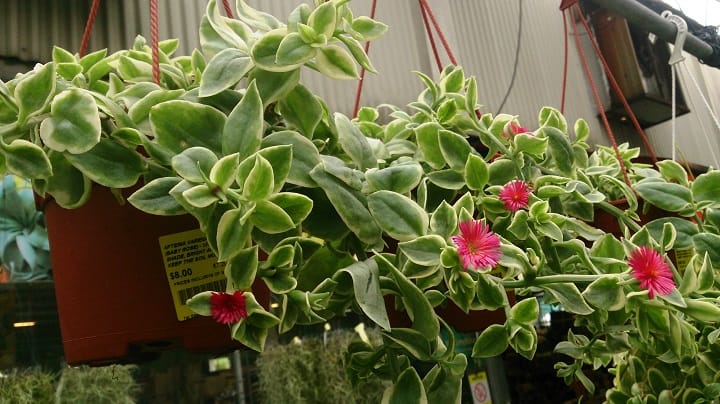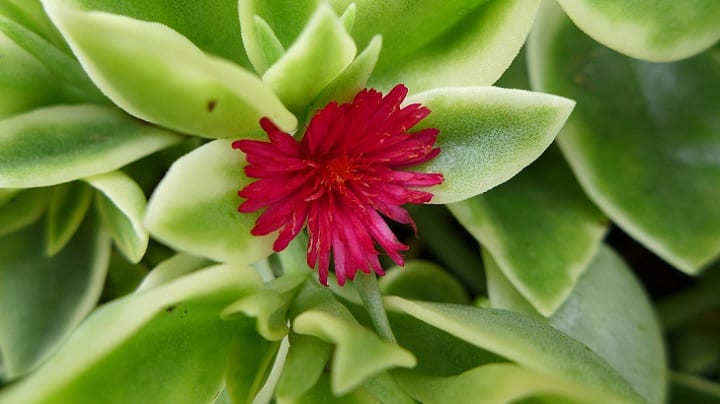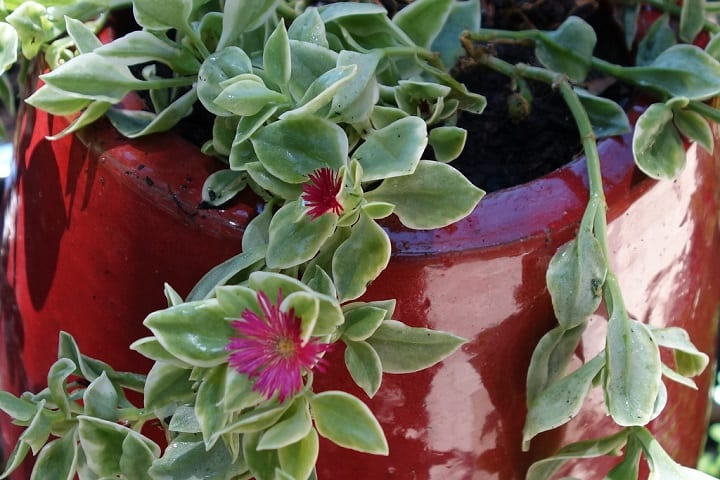Cat’s Tongue Plant: Aptenia Cordifolia Variegata Care
This funny little plant has some hilarious names – cat’s tongue, dew plant, ice plant! Even if you’ve never heard of it before, those names probably make you want to learn more. The cat’s tongue plant is a succulent that’s super simple to grow, yet looks really cool with its thick, tongue-shaped leaves covered in what seems like little water droplets.
Despite its funky appearance, this plant is often overlooked at nurseries. But that just means it’s easy for you to get your hands on one from friends or neighbors who grow it. So let’s dive into what makes this plant so unique and how you can make it thrive in your garden.

Contents
About the Cat’s Tongue Plant
The cat’s tongue plant (Aptenia cordifolia) is a succulent from the same family as living stones and other ice plants. It has a creeping, spreading growth habit, though it can climb up to around 3-4 feet tall if in shade. Give it plenty of water and it will grow like crazy!
The stems start out green and thin but get thicker and woodier over time. The oval or heart-shaped leaves are attached by little stalks. Those droplet-like structures on the leaves, called papillae, give the plant its “dew” appearance and dew plant nickname.
In spring, you’ll see tons of bright pink, delicate flowers with orange centers. It blooms a bit year-round in warm climates. Small green fruits may appear after flowering, but they’re not very showy. Some people in Brazil even eat the leaves and stems – it’s an edible plant!

Where the Cat’s Tongue Plant Grows
Originally from southern and eastern South Africa, the cat’s tongue plant now grows naturally across many parts of the world. In its homeland, it prefers shady, humid areas under trees.
But when cultivated and given lots of sun and water, this plant becomes an absolute beast! It can rapidly take over entire areas, acting as a vigorous ground cover. So be careful where you plant it.
Varieties and Hybrids
There is a variegated form with white leaf edges, though it’s harder to find. You may also come across plants with flowers in different shades like white or yellow – these could be natural mutations or hybrids with other Aptenia species.
One super cool hybrid is ‘Red Apple’, a cross between the cat’s tongue plant and Aptenia haeckeliana. It has even brighter, more vivid pink blooms. Aptenia haeckeliana itself has more elongated leaves and white or yellow flowers.
How to Grow Cat’s Tongue Plants
These plants are about as low-maintenance as it gets! Here are some tips:
- Location – Full sun is best for the fullest, healthiest growth and most flowers. Shady spots will make it get leggy and climb.
- Water – Though a succulent, cat’s tongue needs way more water than most. Allow the soil to barely start drying out between waterings. In winter, cut back a little.
- Soil – It isn’t picky! Well-draining is ideal, but it can handle average or even damp soil. Amend with compost or organic matter for faster growth.
- Fertilizer – Not necessary for plants in the ground, but potted plants will benefit from an occasional feed with compost or balanced fertilizer.
- Cold Tolerance – Can take temperatures down to around 15-20°F. May lose leaves or stems in frost/freezing temps, but will regrow in spring.
- Pruning – Prune to shape the plant, control spread, or remove frost-damaged growth in spring. Also prune off any viney, wayward branches.
Now for the Fun Part – Propagation!
One of the coolest things about cat’s tongue plants is how easy they are to propagate. The stems will readily root wherever they touch soil, so you can simply break off pieces and stick them in the ground.
You can also take stem cuttings from pruned pieces and root those. Or try growing from seed, though it’s much slower and they don’t always sprout true to parent.a
Tips to Keep Aptenia Cordifolia in a Garden
- Prune Regularly – Trim off any wayward, climbing stems to prevent it from overtaking other plants. Also remove any scraggly, messy growth.
- Use as Groundcover – Plant it in areas with just large shrubs or trees that it can’t climb. Or contain it in pots as a spilling accent plant.
- Restrict Growth – Don’t fertilize it and limit water slightly to keep growth more controlled, though this will make it look less lush.
- Create a Hanging Basket – Plant cat’s tongue plant around an upright, winter-hardy plant in a raised container. Let the cat’s tongue trail down the sides for a stunning flowering display.
- Grow in Full Sun – Providing lots of direct light will encourage flattest, most outward growth without as much climbing/vining.
- Avoid Obstacles – Don’t let it grow over or around small plants, rocks, etc. This promotes messy, tangled growth.

Pests and Diseases
One of the best things about cat’s tongue plants is they are extremely tough and pest/disease resistant when grown properly. Here are a few potential issues to watch for:
- Mealybugs – These cotton-like insects may infest stressed, undernourished plants. Treat with insecticidal soap or spray.
- Snails/Slugs – They’re attracted to the moisture-holding leaves. Use baits or hand removal. Usually not overly damaging.
- Chlorosis – Yellowing leaves signify nutrient deficiency, overwatering, or pH issues. Correct with fertilizer, better drainage, etc.
- Rot – Too much moisture can cause fatal stem/root rots. Improve drainage and airflow.
With its quirky looks, hardiness, and easy care, the cat’s tongue plant makes an awesome addition to sunny garden areas! Give this unique succulent a try.
